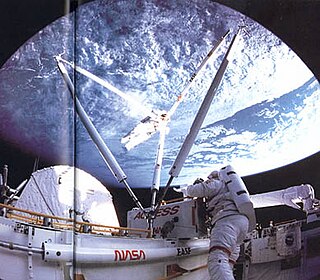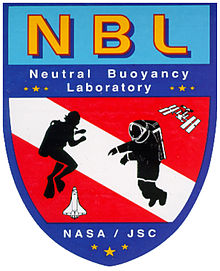
The George C. Marshall Space Flight Center (MSFC), located in Redstone Arsenal, Alabama, is the U.S. government's civilian rocketry and spacecraft propulsion research center. As the largest NASA center, MSFC's first mission was developing the Saturn launch vehicles for the Apollo program. Marshall has been the lead center for the Space Shuttle main propulsion and external tank; payloads and related crew training; International Space Station (ISS) design and assembly; computers, networks, and information management; and the Space Launch System. Located on the Redstone Arsenal near Huntsville, MSFC is named in honor of General of the Army George C. Marshall.

The Lyndon B. Johnson Space Center (JSC) is NASA's center for human spaceflight in Houston, Texas, where human spaceflight training, research, and flight control are conducted. It was renamed in honor of the late US president and Texas native, Lyndon B. Johnson, by an act of the United States Senate on February 19, 1973.

Janet Lynn Kavandi, a native of Carthage, Missouri, is an American scientist and a NASA astronaut. She is a veteran of three Space Shuttle missions, served as NASA's Deputy Chief of the Astronaut Office, and was the Center Director at the NASA Glenn Research Center in Cleveland, Ohio from March 2016 until her retirement from NASA in September 2019. She was inducted into the United States Astronaut Hall of Fame in 2019.

STS-57 was a NASA Space Shuttle-Spacehab mission of Space ShuttleEndeavour that launched June 21, 1993, from Kennedy Space Center, Florida.

A reduced-gravity aircraft is a type of fixed-wing aircraft that provides brief near-weightless environments for training astronauts, conducting research, and making gravity-free movie shots.

Steven Wayne Lindsey is a retired U.S. Air Force officer and NASA astronaut. Lindsey served as Chief of the NASA Astronaut Office from September 2006 until October 2009.

Artificial gravity is the creation of an inertial force that mimics the effects of a gravitational force, usually by rotation. Artificial gravity, or rotational gravity, is thus the appearance of a centrifugal force in a rotating frame of reference, as opposed to the force experienced in linear acceleration, which by the equivalence principle is indistinguishable from gravity. In a more general sense, "artificial gravity" may also refer to the effect of linear acceleration, e.g. by means of a rocket engine.

Neutral buoyancy occurs when an object's average density is equal to the density of the fluid in which it is immersed, resulting in the buoyant force balancing the force of gravity that would otherwise cause the object to sink or rise. An object that has neutral buoyancy will neither sink nor rise.

The Space Systems Laboratory (SSL) is part of the Aerospace Engineering Department and A. James Clark School of Engineering at the University of Maryland in College Park, Maryland. The Space Systems Laboratory is centered on the Neutral Buoyancy Research Facility, a 50-foot-diameter (15 m), 25-foot-deep (7.6 m) neutral buoyancy pool used to simulate the microgravity environment of space. The only such facility housed at a university, Maryland's neutral buoyancy tank is used for undergraduate and graduate research at the Space Systems Lab. Research in Space Systems emphasizes space robotics, human factors, applications of artificial intelligence and the underlying fundamentals of space simulation. There are currently five robots being tested, including Ranger, a four-armed satellite servicing robot, and SCAMP, a six-degree of freedom free-flying underwater camera platform. Ranger was funded by NASA starting in 1992, and was to be a technological demonstration of orbital satellite servicing. NASA was never able to manifest it for launch and the program was defunded circa 2006. For example, Ranger development work at the SSL continues, albeit at a slower pace; Ranger was used to demonstrate robotic servicing techniques for NASA's proposed robotic Hubble Servicing Mission.

The Experimental Assembly of Structures in EVA and the Assembly Concept for Construction of Erectable Space Structures, or EASE/ACCESS, were a pair of space shuttle flight experiments that were performed on STS-61-B, on November 29 and December 1, 1985. The purpose of the experiments was to study how quickly astronauts would become proficient at assembling space structures during extravehicular activity, and how quickly they would become fatigued, and to explore various construction and maintenance techniques. In particular, researchers studied the applied moments of inertia arising in the manual assembly of a large space structure.

The Neutral Buoyancy Simulator was a neutral buoyancy pool located at NASA's George C. Marshall Space Flight Center (MSFC). Engineers and astronauts developed hardware and practiced procedures in this tank from its completion in 1968 through its decommissioning in 1997. Marshall recognized the need for underwater simulations of extra-vehicular activities (EVAs) and developed three successively larger tanks for the purpose. The Neutral Buoyancy Simulator contributed significantly to the American crewed space program. Skylab, the Space Shuttle, Hubble Space Telescope, and the International Space Station have all benefited from the Neutral Buoyancy Simulator. Until Johnson Space Center constructed the Weightless Environment Test Facility in the mid-1970s, MSFC had the only NASA-owned test facility that allowed engineers and astronauts to become familiar with the dynamics of body motion under weightless conditions.
ELIPS - European Programme for Life and Physical Sciences in Space and applications utilising the International Space Station started in 2001 and was intended to cover the activities for the following 5 years. This Microgravity Programme at the European Space Agency (ESA) is an optional programme, with currently 17 ESA member states participating. The ELIPS programme prepares and performs research on the International Space Station, and other uncrewed mission platforms like Sounding Rockets, in fundamental and applied life and physical sciences. ELIPS is the continuation of the earlier European microgravity programmes EMIR 1&2, and the Microgravity Facilities for Columbus, MFC.
Human analog missions are activities undertaken on Earth in various environments to simulate aspects of human missions to other worlds, including the Moon, asteroids, and Mars. These remote field tests are performed in locations that are identified based on their physical similarities to the extreme space environments of a target mission. Such activities are undertaken to test hardware and operational concepts in relevant environments.

Neutral buoyancy simulation with astronauts immersed in a neutral buoyancy pool, in pressure suits, can help to prepare astronauts for the difficult task of working while outside a spacecraft in an apparently weightless environment.

Astronaut training describes the complex process of preparing astronauts in regions around the world for their space missions before, during and after the flight, which includes medical tests, physical training, extra-vehicular activity (EVA) training, procedure training, rehabilitation process, as well as training on experiments they will accomplish during their stay in space.

Hervé Stevenin is a European aquanaut leading ESA Neutral Buoyancy Facility Operations and the EVA Training Unit at the European Astronaut Centre (EAC) in Cologne, Germany. He served as an aquanaut on the NASA Extreme Environment Mission Operations 19 crew.

A neutral buoyancy pool or neutral buoyancy tank is a pool of water in which neutral buoyancy is used to train astronauts for extravehicular activity and the development of procedures. These pools began to be used in the 1960s and were initially just recreational swimming pools; dedicated facilities would later be built.

Mary Helen Johnston, later also Mary Helen McCay, is an American scientist and former astronaut. Working with NASA as an engineer in the 1960s and '70s, Johnston aspired to be an astronaut; she unsuccessfully applied in 1980 before becoming a payload specialist in 1983. Johnston retired from NASA in 1986 without having gone to space. She is a professor at Florida Institute of Technology.




















